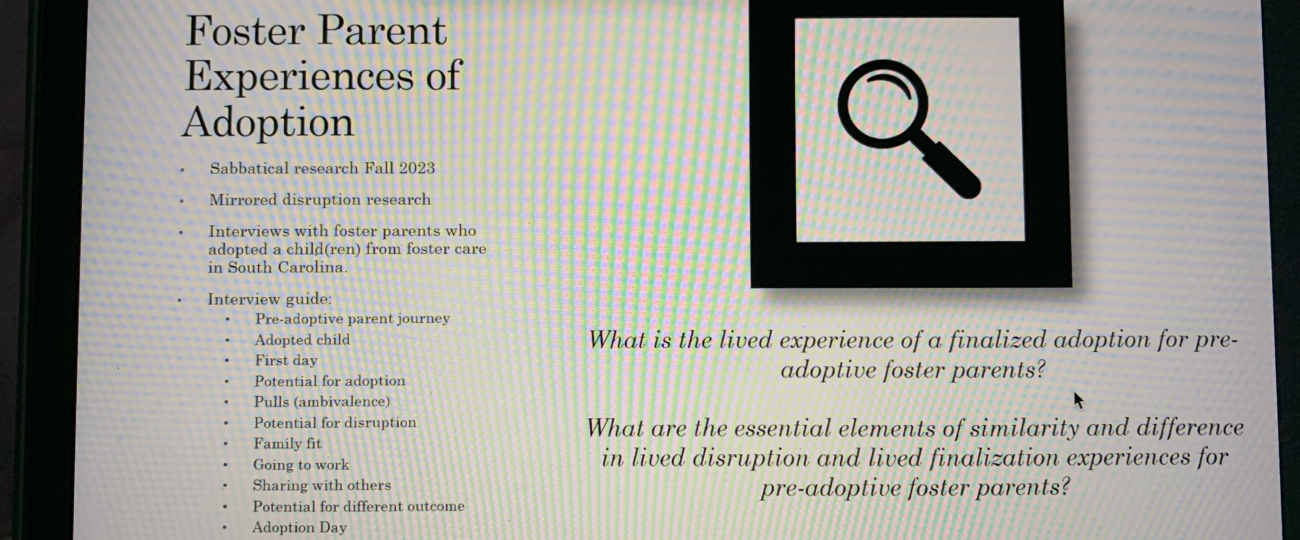The month of March hosts multiple month-long awarenesses, some include by not limited to: Women’s History Month, National Reading Month, Disability Awareness Month and Multiple Sclerosis Awareness Month.
March also hosts National Social Work Month.
To celebrate the month of the profession, associate professor Kori Bloomquist of Winthrop’s social work department and the child and youth well-being minor advisor held a virtual cultural event on March 2, discussing the need for permanency in the foster and adoptive systems.
Associate professor Monique Huggins opened up the conversation and introduced the speaker.
The purpose of this virtual was to celebrate the profession of social work and to educate about childwelfare, social work practice, and research.
Through her research, including three separate rounds of data collection, Bloomquist finds that no states are meeting the timely permanency goals of placing children in homes.
Bloomquist also found that about 391,098 children and youth are in foster care and about 113,00 children waiting for a home.
Other data found included the average waiting time for children in foster care is 7.5 years. These waiting times can differ based on their characteristics.
Some of these characteristics that increase wait time include their race, their sex (with male children less likely to be adopted), whether they have problematic externalized matters and whether or not they have faced sexual abuse.
Children who are adopted are often younger than the ones who are waiting, and by the time a child is seven-years-old, their chances of not being adopted increase each year.
Children who wait longer also face more disruption placements. Disruption placement is when a circumstance causes a child to be removed from an adoptive placement before the adoption was finalized.
According to Bloomquist, there are three types of disruption: child-related factors (when trauma resurfaces and/or parents say they can’t meet needs), family-related (when a child doesn’t feel like a fit in the family) and system-related factors (lack of high-quality systems or when a social worker believes that a child is not adoptable).
One research method Bloomquist used in her studies was phenomenology, or the study of experiences.
Phenomenology “connects the researcher to the world,” Bloomquist said. “I go to people and ask them questions and then they tell me about their lived experiences.”
A problem that presents in her research is that talking about disruption is difficult; therefore, collecting disruption data is challenging.
Bloomquist’s research found that people are less likely to talk about disruption as the losses are often profound. The experience is traumatic not only for the children but also for the parents, other biological and adoptive children in the home and the extended family.
Two primary locations Bloomquist did research were Indiana and South Carolina. Despite the similar circumstance of child disruption, the reactions differed per state.
“When things don’t work out, people often try to find blame,” Bloomquist said.
In Indiana, the families that experience disruption often place blame on those who took care of the kids beforehand. Meanwhile, in South Carolina, families who experienced disruption were more likely to place blame on the child welfare system.
Bloomquist states that this is positive for South Carolina as it strengthens families’ senses to be stronger advocates and create system changes.
In the fall of 2023, Bloomquist took a sabbatical to continue her research. This time, she interviewed foster parents who adopted a child(ren) from foster care in South Carolina. This research study mirrored her disruption research with similar questions and methods.
Compared to the families who faced disruption, those who experienced successful adoption were more willing to talk about their experiences than their counterparts.
Many of the participants said that there wasn’t a question that their adoption wouldn’t go through and that during the process, most didn’t even consider that they would give up their children.
One parent that Bloomquist interviewed said, “You know, it’s crazy–there wasn’t. I don’t think we ever had the thought of sending him back… he thought we would… he’s like ‘you’re just gonna send me away’ and I’m like, no, dude. We chose you…”
Many of the parents agreed that support was essential during the process but despite this, across the country, there is not as much support in post-adoption.
“We don’t take good enough care of families post-adoption,” Bloomquist said.
An example given was of a parent who couldn’t get any support when their adoptive child acted out. The only way the parent could receive support from any services was by pressing charges against her kid, who was only 12 at the time.
Bloomquist said that her next steps would include improving the permanency practice with adoption.
“I’m very passionate about this work,” Bloomquist said.
Bloomquist would also like to reduce the stigma that only a particular type of family can adopt.
For example, four percent of adoptive families are non-married men. By raising awareness towards the diverse family types, Bloomquist believes that this would raise inclusivity in the foster care and adoption systems, which advocates for the belief that all families of all various kinds can be eligible to adopt.




